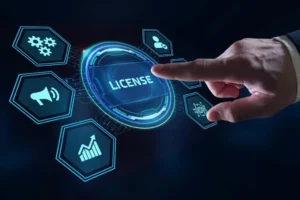The correct management of software licenses is critical for companies of all industries and sizes. Ensuring compliance with licensing guidelines is critical to avoiding legal and financial risk. A crucial part of this process is tracking changes to the lists of technologies eligible for sub-capacity licensing.
Under the new IBM Software licensing policies, the customer has an obligation when acquiring and agreeing to the terms, ensure the software license management and if it does not have the capacity to guarantee management, it is necessary to implement the IASP.
On June 26, 2023, IBM published the dates for the removal of technologies not supported by the sub-capacity licensing process, it is important that your company guarantees compliance with current licensing regulations, to avoid fines and penalties, in addition to guaranteeing an environment up-to-date and secure software.
In this article, we're going to talk about the timeline for removing technologies from the sub-capacity eligibility list. The list of eligible technologies is an important reference for companies that want to use the IBM License Metric Tool (ILMT) accurately and efficiently.
What is the list of technologies eligible for sub-capacity licensing?
The list of technologies eligible for sub-capacity licensing specifies the technologies and versions that are considered eligible for sub-capacity reporting, that is, they are likely to be licensed according to actual capacity usage.
The use of sub-capacity licensing allows you to pay only for the software resources actually used, instead of purchasing licenses for the full capacity of the system. This brings significant benefits, such as cost reduction and better use of IT resources.
Compliance with the guidelines on the list provides transparency in the use of software licenses, allowing you to have a clear and accurate view of your licensing needs. This helps in optimizing costs, allowing adequate adjustments in licenses according to the real demands of the organization.
It is important to understand that the list of technologies eligible for sub-capacity licensing is regularly updated by IBM. New technologies are added, while others may be removed based on the end of support by vendors. It is therefore essential to follow up on list updates to ensure they are in compliance and enjoying the full benefits of sub-capacity licensing.
Technology Removal Plans
The following is a table containing technologies that have reached end of support by vendors, along with planned removal announcement dates and specific removal dates from the list of technologies eligible for sub-capacity. It is essential to keep track of these dates to ensure compliance and smooth functioning of the ILMT.
| Technology | End of vendor support | Planned removal announcement | Planned removal from the list of technologies eligible for sub-capacity licensing and supported by License Metric Tool |
| Windows 8 | 10/01/2023 | End of 1Q 2023 | End of 3Q 2023 |
| Windows 8.1 | 10/01/2023 | End of 1Q 2023 | End of 3Q 2023 |
| AIX 6.1 | 30/04/2022 | End of 3Q 2022 | End of fourth quarter of 2023 |
| Ubuntu 18 | 30/04/2023 | End of 1Q 2023 | End of 4Q 2023 |
| vSphere 6.5 | 15/10/2022 | End of 4Q 2022 | End of 4Q 2023 |
| vSphere 6.7 | 15/10/2022 | End of 4Q 2022 | End of 4Q 2023 |
| IBMi 7.2 | 30/04/2021 | End of 1Q 2023 | End of 2Q 2024 |
| AIX 7.1 | 30/04/2022 | End of 1Q 2023 | End of 2Q 2026 |
| Windows Server 2012 | 10/10/2023 | End of 2Q 2023 | End of the 3rd quarter of 2024 |
| Windows Server 2012 R2 | 10/10/2023 | End of 2Q 2023 | End of the 3rd quarter of 2024 |
These dates represent IBM's plans to remove technologies from the eligibility lists. The planned removal from the list of subcapacity-eligible technologies supported by License Metric Tool can have significant impacts on the tool's usability.
When utilizing technologies that are being delisted, it is important to consider appropriate actions to ensure compliance. This could include upgrading to newer versions of technologies or migrating to compatible alternatives, if you need upgrade support and want to ensure your enterprise is in compliance with licensing guidelines, Click here to request support from a 4Matt expert. We are ready to assist your company throughout the upgrade and compliance process.
Change history
The following is a history of changes to the list of technologies eligible for sub-capacity licensing. These are the technologies that have already been removed from the sub-capacity eligibility list, along with vendor end of support dates and removal dates from the list.
| Technology | End of vendor support | Planned removal announcement | Date removed from the list of technologies eligible for sub-capacity licensing and supported by License Metric Tool |
| Debian 9 | 30/06/2022 | End of 3Q 2022 | End of the first quarter of 2023 |
| HP-UX all versions | End of 4Q 2021 | End of 4Q 2022 | |
| SUSE Linux Enterprise 11 | 31/03/2019 | End of 2Q 2021 | End of 2Q 2022 |
| Ubuntu 16 | 4/2021 | ||
| RHEL 5 on | 31/10/2020 | ||
| IBMi 7.1 | 30/04/2018 | ||
| Oracle VM Server for x86 | 31/03/2021 | End of 1Q 2021 | End of 4Q 2021 |
| OracleLinux 6 | 31/03/2021 | End of 1Q 2021 | End of 3Q 2021 |
| CentOS 6 | 30/11/2020 | End of 4Q 2020 | End of 2Q 2021 |
| Debian 8 | 30/06/2020 | ||
| VMware vSphere 6.0 | 12/03/2020 | ||
| Windows 2008 | 14/01/2020 | End of 1Q 2020 | End of 1Q 2021 |
| Windows 2008 R2 | 14/01/2020 | ||
| windows 7 | 14/01/2020 | End of 1Q 2020 | End of 4Q 2020 |
| IBMi 6.1 | 30/09/2018 | End of 1Q 2020 | End of 2Q 2020 |
| Debian 7 | 31/05/2018 | End of 4Q 2019 | End of 1Q 2020 |
| IBM i 5.x | 30/09/2013 | ||
| RHEL 5×86 | 31/03/2017 | End of 4Q 2019 | |
| RHEV 3.x | 30/09/2017 | ||
| Solaris 10 | 30/01/2018 | End of 4Q 2019 | |
| ubuntu 12 | 28/04/2017 | End of 4Q 2019 | |
| Ubuntu 14 | 30/04/2019 | End of 4Q 2019 | |
| vSphere 5.x | 19/09/2018 | End of 4Q 2019 | |
| Windows Vista | 13/04/2010 | ||
| XenServer 6.x | 30/06/2018 |
By tracking change history, companies can get a clear view of which technologies have been removed from the list over time. This allows you to identify which technologies are no longer eligible for sub-capacity licensing and take the necessary steps to upgrade or migrate to newer, supported versions.
It is essential to highlight that removing these technologies from the list can have a significant impact on the use of License Metric Tool. Therefore, it is critical to closely monitor updates and removals, ensuring that the organization is in compliance with licensing guidelines and utilizes supported technologies.
Also, it is important to note that IBM continues to update the list of technologies eligible for sub-capacity licensing on a regular basis. Keeping up with updates is crucial to ensuring continued compliance and reaping the benefits of sub-capacity licensing.
Conclusion
With the technology market constantly evolving, it is natural that some technologies become obsolete. But keeping an up-to-date list of technologies takes time and effort, something many companies and individuals lack, especially when they are busy with other business demands.
For this you can count on the experience of 4matt, our experts assist you in all stages of the software license management process, from technology list updates, to complete licensing management ensuring a better result in compliance with international policies to the growth of the competitiveness of the business, being able to develop customized solutions for each business need.
We are here to assist you through the compliance process and ensure your organization enjoys the full benefits of sub-capacity licensing.

